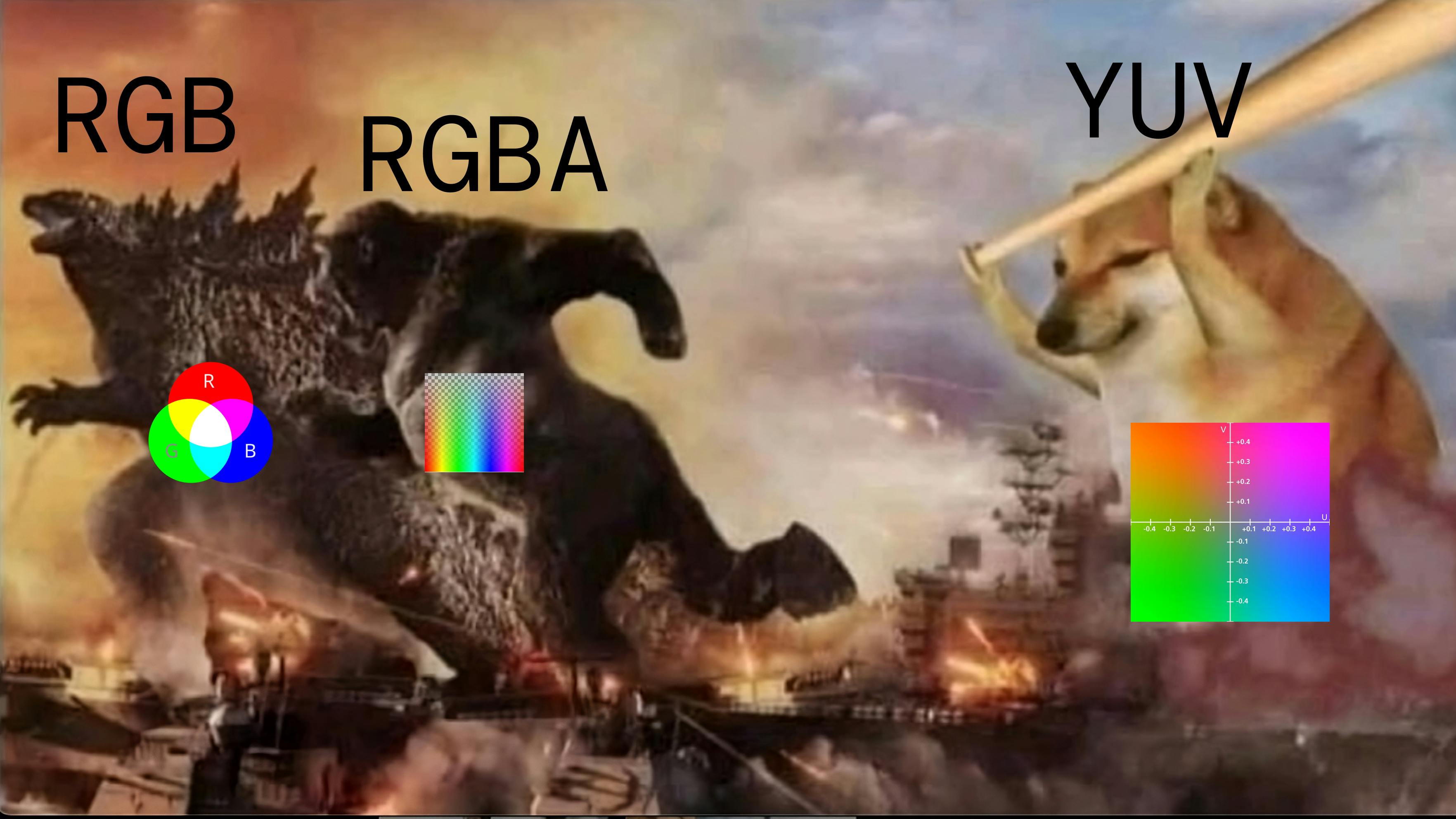After spending dozens of sleepless nights working with YUV color encoding formats, I realized how little information is available about this remarkable format. Yet, it can be incredibly useful for those involved in P2P video streaming or processing video streams with AI.
At first glance, RGB and YUV might seem like just different ways of representing color. But beneath this distinction lies an ongoing battle: convenience vs. efficiency, accuracy vs. performance, perfect perception vs. compression without visible loss. One might assume that RGB is the undisputed king of color spaces—after all, cameras, screens, and most neural networks operate in it. However, in the world of video streaming and encoding, YUV takes the lead, hiding under the hood a series of complex trade-offs that allow us to watch videos without lag, save gigabytes of data, and accelerate real-time processing.
But what if you want to bridge these two worlds? How do AI models trained on RGB handle video streams in YUV? Why are codecs so reluctant to work with RGB? And is it possible to achieve the perfect balance between these formats? Here, I’ll help you dive into why RGB and YUV are like two boxers from different weight classes, forced to meet in the same ring of video streaming and AI technology.
RGB and YUV: What Are They?
RGB and RGBA formats are fairly straightforward and widely used in computer graphics, so we won’t dive too deep into the basics. In short, when your computer renders an image, it operates with three channels—Red (R), Green (G), and Blue (B). This is how most screens function.
RGBA adds an additional channel — Alpha (A) — which controls transparency, making it particularly useful for web graphics and digital design. RGB accurately represents colors without distortion, but it has a critical drawback—it takes too much space. For example, an image with a resolution of 1920 × 1080 in RGBA format (using 1 byte per channel) takes up: 1920×1080×4 = 8294400 bytes ≈ 8.2 MB
Compressed formats like JPEG reduce file size, but in the world of P2P video streaming and AI real-time processing on clients’ machines — such as object recognition, key-point detection, and segmentation — this isn’t a viable option. We need to transmit and analyze every frame in real time, without introducing compression artifacts or losing critical details. That’s where YUV comes into play, offering a smarter approach to balancing quality, efficiency, and performance.
What is YUV?
Unlike RGB, which stores color information directly, YUV separates an image into luma (Y) and chroma components (U and V). This approach enables efficient data compression without significant quality loss.
Y (Luma, brightness) – Represents the pixel’s brightness, determining how light or dark it appears. Essentially, this is the grayscale (black-and-white) version of the image, preserving all shapes and details.
U and V (Chroma, color) – Store color information but with lower precision since the human eye perceives brightness more sharply than color accuracy. Simply put, these channels act as a two-dimensional “shift” of brightness toward different color hues.
This separation is the key to why YUV is so effective for video compression, streaming, and AI-based video processing.
Why is YUV Better for Video Streaming?
One of YUV’s less obvious but highly effective advantages is that one of its channels (Y) isn’t meant for storing color at all. Instead, it precisely describes the
How is This Related to Human Vision?
The human eye perceives images using two types of photoreceptors in the retina:
-
Rod cells (~120 million) – Sensitive to brightness and contrast but incapable of detecting color. They allow us to see shapes and details even in low light.
-
Cone cells (~6 million) – Responsible for color perception but are 20 times fewer in number. They function only in good lighting conditions and come in three types: red, green, and blue (RGB, unsurprisingly).
Because of this receptor imbalance, our brains prioritize shape over color. If brightness or contrast is distorted, we notice it immediately. However, slight color shifts often go unnoticed.
This Is the Core Principle of YUV
- The Y channel (brightness) remains unchanged to preserve object shapes so rod cells in your eyes will be pleased.
- The U and V channels (color information) can be compressed without creating visually noticeable artifacts and fewer cone cells won’t notice any difference difference.
This means that unlike RGB — where all three channels are equally important — YUV treats its channels differently based on human perception. Since color data (U and V) is less critical, we can reduce the amount of transmitted data without losing perceptible quality.
This is exactly how the Chroma Subsampling mechanism works — optimizing video encoding by selectively compressing color information while keeping brightness intact.
How Chroma Subsampling Saves the World of Video Streaming
Chroma subsampling is a technique for reducing the amount of color data in an image. Instead of storing color for every pixel (as in RGB), YUV lowers the resolution of color channels while keeping brightness (shape) intact.
There are several industry standards for chroma subsampling:
-
4:2:2 subsampling – Each pair of pixels shares color information. The eye barely notices the difference, but the file size is reduced by 33%. This method is rarely used.
-
4:2:0 subsampling – Color is stored for only one pixel out of four, achieving maximum compression.
Why Is 4:2:0 the major standard?
This format cuts data size in half without noticeably degrading image quality. That’s why it’s the go-to standard for nearly all streaming services and video platforms. For example, Microsoft Teams transmits video at 4:2:0 because it provides the best balance between quality and bandwidth efficiency.
In this setup, a single color value represents four pixels, and the human eye doesn’t detect the difference—even when zoomed in—since the brightness (Y) remains unchanged.
1920×1080×1.5 = 3110400 bytes ≈ 3.1 MB on a single frame, this results in more than a twofold reduction in data size compared to RGBA — without any visible loss in quality!
Image below shows how the the final frame/image looks like with 4:2:0 chroma subsampling. Note how one U describes four Y, it 4 times memory win!
Why Is YUV So Useful for AI?
In today’s world, AI applications for real-time video processing are rapidly expanding. Neural networks are used not only for surveillance camera analysis and stream quality enhancement but also for more complex tasks such as generative effects, real-time appearance modification, object recognition, and motion tracking.
For example, we developed a virtual makeup system that applies lipstick and eyeshadow to a person’s face in a video chat—doing so as realistically as possible. In such tasks, precision in shape and movement is critically important, while color information is secondary. You also can train your model to understand the greyscale images to boost its performance, at the same time, getting greyscale images on the GPU is much more efficient if you take YUV 4:2:0 as an input, since you only need to cut the first part of the image to get the resulting greyscale channel.
Key Challenges in AI Video Streaming
Shape matters more than color
AI models, like many other computer vision systems, focus primarily on object structure, shape, and edges rather than precise color reproduction. This is true for face recognition, pose tracking, anomaly detection, and AR effects. For example, in a motion recognition system, the pixel outline of a body is far more important than skin tone.
Performance is critical
For real-time AI, each frame must be processed in under 20 ms to maintain a smooth frame rate (50–60 FPS). The faster a neural network receives and processes frames, the more natural and fluid the application runs.
- RGB formats are too heavy – A
1920×1080RGBA frame weighs8.2 MB, putting immense strain on memory and processing power. - YUV with 4:2:0 chroma subsampling reduces unnecessary data in
O(1)by transmitting color at a lower resolution, saving computational resources without visible quality loss.
Optimized GPU Processing
Modern GPUs are highly optimized for YUV processing, meaning we can work with images without converting them to RGB. This eliminates unnecessary computations and boosts processing speed.
Bandwidth and Memory Savings
Reducing data size is critical for real-time video transmission and processing:
- In streaming, using YUV 4:2:0 cuts data transmission by 50% without noticeable quality loss.
- In AI, models can process compressed data without inflating it to RGB, saving VRAM and computational power.
Conclusion
Let’s be honest — RGB seems like the obvious choice. It’s the standard in cameras, screens, and computer graphics. But when it comes to real-world video streaming and AI integration, RGB turns into a sluggish dinosaur. Then YUV steps into the ring, offering the perfect balance of quality, speed, and data efficiency. Its clever storage system (separating brightness from compressed color) enables things that would be a computational nightmare in RGB.
- Less data = more speed. Nobody wants extra megabytes slowing down real-time video processing.
- The eye doesn’t notice the trick. Our brain focuses on shape, not minor color losses — YUV takes full advantage of this.
- AI cares about FPS, not color nuances. When you have just 16ms per frame, YUV eliminates unnecessary calculations and saves resources.
- GPUs love YUV. Hardware-accelerated codecs, fast computations, and minimal format conversions—everything you need for high-performance video.
Final Verdict
RGB is great — but not where real-time performance and AI are involved. In video streaming, YUV is the true workhorse and has been powering major solutions for years.
So, if you still think RGB is king, it’s time to rethink. Video formats have long played by their own rules.












